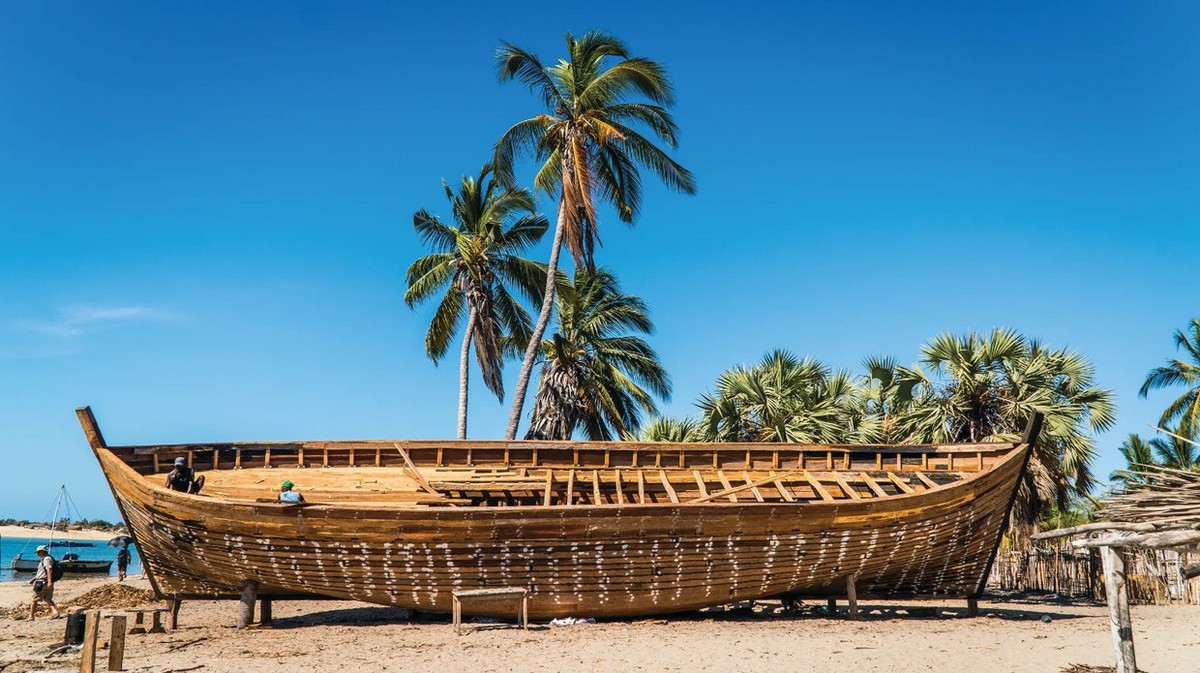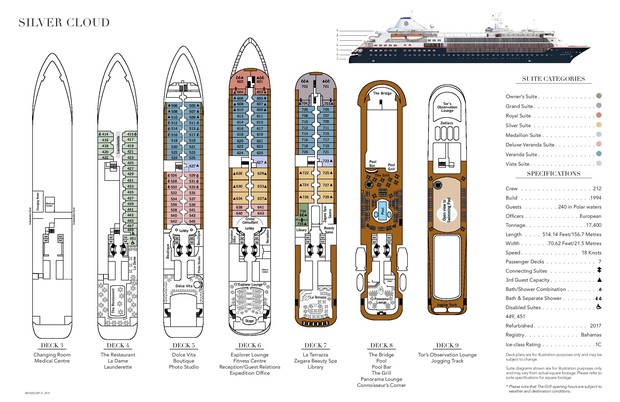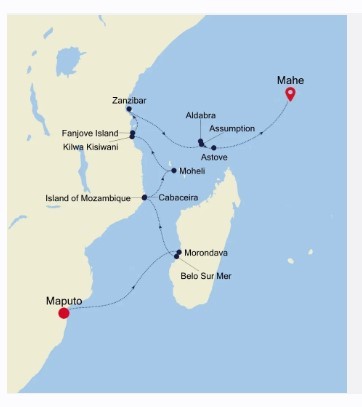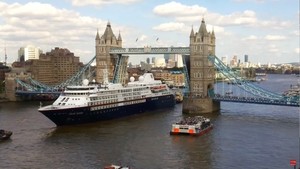
Five fantastic countries offer an incredible palette of the Indian Ocean. Departing from Mozambique, your first destination will be Madagascar, where you’ll fall in love with the island’s famous lemurs. The Island of Mozambique, offers a fascinating glimpse into life on the island in the 16th century. Then continue on to Comoros and Tanzania for wildlife and wondrous views. After a day on Assumption Island in the Seychelles, spend three days exploring Aldabra Island, one of the most unique islands in the world.
- Immerse yourself in the unique charm of Maputo, Mozambique, with its rich blend of African, Portuguese, and Arab influences, all within a day's visit.
- Explore the exotic landscapes of Madagascar, including Morondava and Belo Sur Mer, where you can witness stunning natural beauty and perhaps encounter rare wildlife.
- Discover the historical significance of Island of Mozambique and Cabaceira, both offering intriguing excursions that delve into the region's heritage and culture, before continuing your journey through the mesmerizing Indian Ocean.
There are no future departures for this trip at this stage.
Maputo is not known for being the capital of Mozambique, but also for the buzzing vitality that is unfound elsewhere in Africa. The end of 15 years of civil war in 1992 saw an economic uprising and visitors to Maputo today are just as likely to come for the busy bars and restaurants as they are to enjoy colonial architecture worthy of the Mediterranean. Maputo is different from other cities in the region. It’s magical. There is a story book quality to the city, an almost palpable belief that someday Maputo will be recognised as the leading city it is. And nothing – not the floods nor the drought that plagues so many other parts of Africa will be able to stop it. Glimpses of this self-confidence are everywhere, from the lively music that spills out onto the street to the eccentric belief that building a cast iron house in Africa was a good idea. Head for the town square to see the latter for yourself. Formerly known as Lourenco Marques, the city was named after a Portuguese explorer who landed here in 1544. Most of the city’s infrastructure (and architecture) was destroyed during the war years, but thankfully a few must see places remain. The train station – often incorrectly attributed to Gustave Eiffel, is one of the world’s most beautiful buildings, a large-domed, green and white steel structure that would look more at home in Lisbon. The gleaming white Roman Catholic cathedral, the neo-classical City Hall and the French-Mozambican cultural centre are all also top of sightseers lists.
Days at sea are the perfect opportunity to relax, unwind and catch up with what you’ve been meaning to do. So whether that is going to the gym, visiting the spa, whale watching, catching up on your reading or simply topping up your tan, these blue sea days are the perfect balance to busy days spent exploring shore side.
Morondava is a coastal town in the west of Madagascar. The city is most known for its picturesque Avenue of the Baobabs, one of the most accessible places to see the Baobab trees in Africa that is also said to be the most beautiful road in Madagascar. The experience of passing along this road is impressive as a row of imposing Baobab trees stretches along the roadside for close to one-third of a kilometer. The avenue has been a centre of local conservation efforts and was granted protected status, which is the first step toward making it Madagascar's first natural monument. Visitors may see nearby Kirindy Reserve, one of the most outstanding and threatened wildlife habitats in Madagascar known as the ‘dry deciduous forest.’ In addition to the magnificent baobab trees, the reserve is home to the world’s smallest known primate as well as dozens of amphibian and reptile species.
Belo Sur Mer is a rarely-visited, lovely Vezo fishing village located about 80 km south of Morondava, Madagascar. The town is referred to as a commune, with a population of 8,000 that consists primarily of the Vezo people. The Vezo have an ocean-oriented, semi-nomadic culture but call southern Madagascar their home. Visitors to Belo Sur Mer will be welcomed by a pristine long stretches of bright white sandy beaches and stunning turquoise waters. Take in the relaxed atmosphere, the bold red sunsets and learn from the locals who preserve their traditional ways of living.
Days at sea are the perfect opportunity to relax, unwind and catch up with what you’ve been meaning to do. So whether that is going to the gym, visiting the spa, whale watching, catching up on your reading or simply topping up your tan, these blue sea days are the perfect balance to busy days spent exploring shore side.
The densely populated Mozambique Island is small at only 3 km (1.9 miles) long and less than 500 meters (650 yards) wide. The Portuguese had already settled here by 1507, and the oldest European building in the southern hemisphere is found on Mozambique Island: the Chapel of Nossa Senhora de Baluarte. Fort São Sebastião also dates back to the 16th century. Historical buildings on the northern side of the island include the Palace and Chapel of São Paulo, built in 1610 as a Jesuit College — later converted to be the Governor’s Residence, and now a museum. As a result of its rich history and architectural remains, the Island of Mozambique is a UNESCO World Heritage Site. The majority of the residents today live in reed houses in Makuti Town at the southern end of the island. In addition to the old Christian churches there are several mosques and even a Hindu temple on the island. For the last 55 years a 3 km (1.9 mile) bridge has connected the island to the mainland.
Tropical rainforests, stunning beaches and rich mangrove formations await on this isolated island realm. Formed by the underwater volcanoes that fuel feisty Mount Karthala, Moheli is recognised as the most biodiverse of the Union of Comoros’s handful of islands. The small archipelago country bathes in the Indian Ocean, scattered between Mozambique’s coastline and the northern tip of Madagascar. The 40,000 residents here speak a melange of languages, including French, Arabic and Comorian, reflecting the blend of influences. Mohéli National Park helps conserve the lush rainforests, incredible animal life and sea terrain. Proudly nominated as a UNESCO Biosphere Reserve, the park is a sustainability success story that offers a much-needed haven to green sea turtles and critically endangered hawksbill sea turtles. See the magical turtles laying bundles of eggs below the moonlight, and watch as precious hatchlings scratch and scramble across the sand to the sanctuary of the Indian Ocean’s waves. Offshore and dolphins cruise the channel’s currents, dugongs chew their way through seagrass fields, and gorgeous coral reefs teem with effervescent life.
Days at sea are the perfect opportunity to relax, unwind and catch up with what you’ve been meaning to do. So whether that is going to the gym, visiting the spa, whale watching, catching up on your reading or simply topping up your tan, these blue sea days are the perfect balance to busy days spent exploring shore side.
Kilwa Kisiwani dates back to the 9th century as one of the most famous trading posts in East Africa and on the Indian Ocean. From the 11th century to early 15th century this island community off the southern coast of present-day Tanzania was a powerful city, political force, and major trading center with close links to the interior of Africa as well as distant Asian ports. Goods exchanged here included gold, iron, ivory, slaves, textiles, jewelry, porcelain and spices. Today, Kilwa Kisiwani is a UNESCO World Heritage site whose ancient ruins can be explored on foot. From the Malindi Mosque and cemetery, to Fort Gereza, the tombs of the sultans, several mosques, and the Great House, the site allows the imagination to experience the Kilwa Sultanate that once ruled here. Highlights include a fourteenth century palace — no structure of its size was built anywhere else along the coast – and a fortified enclosure, very similar to structures found in Syria, Turkey and the Persian Gulf.
Kick off your shoes - you won’t be needing them during your time on this indulgent Indian Ocean island of powdery white sands and shallow tempting seas. A tiny droplet of sand, palm trees and chalky-blue waters rising from the Indian Ocean, Fanjove Island is one of Tanzania’s most divine revelations. One of the six Songosongo Islands, this nature-dominated bead of sand is an island sanctuary where natural wonders comes to the fore - as coconut crabs scuttle and the melodies of bird life intertwine with the gentle whispers of the waves. There are no crowds, but you won’t be lonely with sleek dolphins, humpback whales and reef sharks all among the natural visitors gracing this heavenly island’s sandy shores. Explore the brilliant blue surface from a traditional dhow or dive into the thriving coral reef. Glass-clear waters beg you to swim and snorkel, exploring a colourful collage of angelfish and clownfish, ducking and darting between their coral shelters. Sustainable, thatched buildings add to the island’s peace and tranquillity, while a pretty white lighthouse provides an attractive focal point on the blissful beach. An Indian Ocean dream of seductive tranquillity and soothing rejuvenation. Prepare yourself for barefoot walks below leaning palm trees, and evenings viewing skies erupting with violent colours during sunset before the smoky bands of the Milky Way unfurl. A simple and seductive isle of sustainable, eco-friendly facilities, where the remarkable natural setting is the star of the show.
A tropical paradise, with swathes of long white sand and flanked by tall, skinny, palm trees, Zanzibar sits in the clear blue waters of the Indian Ocean. Part of the Zanzibar archipelago, the island – also confusingly called Zanzibar – is found just 22 miles from mainland Tanzania. Considered today as a honeymooners’ paradise, visitors will find vestiges of both Arabic and Portuguese colonialism (the island was Portuguese until 1698 when it was seized by the Sultanate of Oman), amid the picture perfect landscape. But there is much more to Zanzibar than meets the eye. With just one step off the ship, and you are already breathing the heady scents of nutmeg, cinnamon, vanilla and cloves. Rightfully known as the Spice Isle, Zanzibar was once a trading hotspot on the trading route from Arabia to Africa. At the time, the island enjoyed an influx of wealth and European bourgeoisie, with spices being traded at astronomical prices. The influences of the various colonies are glamorously reflected in the main city’s architecture. But sensual smells and beautiful beaches aside, Zanzibar has the vestiges of sinister history. The island was a capital for the slave trade in the 19th century, with an estimated 50,000 slaves passing through the Zanzibar slave market each year, with many more dying en route. The epicentre for trade was in the Market Square, in the heart of Stone Town, a melting pot of Arabic, African and European history that today is one of the world’s most popular UNESCO World Heritage Sites.
Days at sea are the perfect opportunity to relax, unwind and catch up with what you’ve been meaning to do. So whether that is going to the gym, visiting the spa, whale watching, catching up on your reading or simply topping up your tan, these blue sea days are the perfect balance to busy days spent exploring shore side.
Assumption (Assomption) Island is a small, crescent shaped island about 4.3 square miles (11.07 sq km) in size. Considered one of the Outer Seychelles Islands, Assumption is part of the Aldabra Group, lying approximately 600 miles (960 km) southwest of Mahé, in the Indian Ocean. These outer islands are not made from granite, like their larger sisters Mahé, Praslin or La Digue, but rather are coralline formations. Once a part of the French colony Réunion, then a member of the British Indian Ocean Territories, today Assumption is governed by the Seychelles. Assumption is a rough and arid island, shaded only by shrubs and palm trees but is redeemed by a spectacular reef with huge coral heads and a white ocean floor. Jacques Cousteau said he'd never seen any other place on earth with same clarity of water or diversity of reef life. He filmed large parts of documentary “The Silent World” here, and held audiences across the globe, spellbound by the magic that lay beneath the sea. A notable feature of this island is the Assumption Island day gecko, a subspecies of gecko found only on this island. Assumption is also a known nesting site for turtles and rare birds. Because Assumption Island was found to be rich in guano, coveted for its phosphorous fertilizing abilities, it was essentially plundered in the early 1900s. The island today is has an interesting geography that includes a gorgeous 3-mile (5-km) white beach, a rocky coastline, caves, and two very large sand dunes prominent on the south eastern coast of the island, one of them reaching 104 feet (32 metres) high. There is a very small settlement with less than 10 registered inhabitants, mostly in place to service the small landing strip used by scientists with permission to study the neighbouring Aldabra Atoll. The settlement is surrounded by Casuarina trees and there is an abandoned coconut palm plantation to its south. Pier Information The ship will be anchored off the coast of Assumption and tenders will land on the shoreline. We recommend you wear sturdy walking shoes, sun hats or scarves and bring your camera. Independently explore the island and relax on this peaceful dot in the ocean. Part of the Outer Islands of the Seychelles, Aldabra is reputedly the world’s second-largest atoll and has been described as “one of nature’s treasures” and a “sanctuary”. The inner lagoon teems with marine life like eagle rays and sea turtles. It is possible to snorkel and drift along with the tide passing in or out of the lagoon as massive numbers of fish come and go through the same channels. Narrow channels between fossilized coral islands are fringed in mangrove forests supporting large colonies of nesting boobies and Great Frigatebirds. Its distinctive island fauna includes the Aldabra giant tortoise (Aldabrachelys gigantea). Approximately two-thirds of the world’s population of giant tortoises lives on Aldabra – some 100,000 out of a reported 150,000. Because of its extreme isolation in the blue of the Indian Ocean, and due to a lack of freshwater, the island has not been developed for tourism. No airport has been built, and only a handful of smaller ships with special permits are allowed to call at this unique atoll.
Awake the adventurer in you on Astove. Large atoll, part of the Outer Islands of the Seychelles, Astove is one of the remotest island of the archipelago. Other than its perfect beaches fringed with palm trees, this raised coral island has many stories to tell. Probably explored by Arab seamen and merchants between 1000 and 1500 AD, the first record of human presence on the atoll dates back to 1760. A community of slaves formed after they were abandoned on the island by a Portuguese frigate boat. After the last of them were picked up and taken away to Mozambique at the end of the 18th century, the island remained unoccupied. Until the arrival of the British businessman Mark Veevers-Carter and his family in 1968. Adventurers at heart, they successfully founded a copra plantation and chose to settle on Astove. The couple built a big house, small residencies for the Seychellois employees, a chapel, a processing centre, and a shop. His wife Wendy, who was the author Clarence Day’s daughter, even chronicled their atypical islander life with their children for an American newspaper in 1969. After the family left the island in 1970, their house was transformed into a fishing resort. That’s only in 2014 that Astove was declared a nature reserve. A reserve that is home to plenty of seabirds and extraordinary flora. The atoll is surrounded by a shallow lagoon surrounded itself by a steep drop off also called ‘The Wall’. This spot is notably known to be a scuba diving and snorkelling paradise. The waters bordering Astove are home to fan corals and a plethora of fishes. In this dramatic scenery, expect yourself to also bump into sea turtles and Aldabra tortoises, the queens of the Seychelles.
Days at sea are the perfect opportunity to relax, unwind and catch up with what you’ve been meaning to do. So whether that is going to the gym, visiting the spa, whale watching, catching up on your reading or simply topping up your tan, these blue sea days are the perfect balance to busy days spent exploring shore side.
Few places on Earth can claim to have been as blessed by nature as Mahe. Set in the remote Seychelles archipelago over 1,500 kilometres east of Mombasa, Mahe is largest of the 115 islands and is home to so many stunning attractions you won’t know where to begin. For many the Seychelles are the destination of a lifetime. Cerulean seas, miles and miles of beach, lush, tropical jungle and surreal, natural beauty as far as the eye can see. Not only does Mahe boast 68 pristine beaches, it is dominated by the towering peaks of the Morne Seychellois National Park. This splendid National Park takes up over 20% of the island and is home to a vast amount of endemic flora and fauna, including the ultra-rare Seychelles Scops-owl. Unsurprisingly, the crystal clear waters are a diver’s heaven, promising a colourful cornucopia of underwater life, regardless of how experienced you are. Despite the island being visited in 1609 by the British, Mahe did not feature on any maps until 1742, when Frenchman Lazare Picault explored the as yet unnamed islands. However, it took a further 14 years for the French to lay claim to the islands, with the arrival of naval ship Le Cerf, captained by Corneille Morphey who christened the archipelago after Vicomte Moreau de Sechelles. He did this by setting down a Stone of Possession, which is on display in the National Museum. The first settlers arrived in 1770 and 15 years later the population had swelled to 130 – 7 Europeans and 123 slaves. Today, there are 80,000 Seychellois.
Itineraries are subject to change.
Silver Cloud

| Refurbished: | 2017 |
|---|---|
| Crew | 212 |
| Tons | 17400 |
With 18-brand new Zodiacs, four superlative restaurants in Antarctica and a pole to pole expedition itinerary, Silver Cloud really does break the ice between expedition and luxury. Spacious yet intimate, designed to cross oceans and yet able to slip up rivers and into hidden harbours with ease, the yacht-like Silver Cloud carries just 296 guests in incomparable comfort and style. Combining spacious ocean-view suites and private verandas with stunning dining and entertainment options, Silver Cloud provides world-class cruise accommodations, service and amenities.
After extensive refurbishment, Silver Cloud is the most spacious and comfortable ice class vessel in expedition cruising. Her large suites, her destination itineraries and her unparalleled service make her truly special. Her four dining options will tantalise your taste buds and as 80% of her suites include a veranda, watching a breaching whale or a few cavorting penguins has never been so personal. She carries a limited number of guests in polar waters, meaning that Silver Cloud has the highest space to guest and crew to guest ratios in expedition cruising. With her 18 zodiacs, 10 kayaks, possibilities are almost limitless with ship-wide simultaneous explorations.



